
Construction materials company Vulcan Materials (NYSE:VMC) fell short of the market’s revenue expectations in Q2 CY2025 as sales rose 4.4% year on year to $2.10 billion. Its non-GAAP profit of $2.45 per share was 2.8% below analysts’ consensus estimates.
Is now the time to buy Vulcan Materials? Find out by accessing our full research report, it’s free.
Vulcan Materials (VMC) Q2 CY2025 Highlights:
- Revenue: $2.10 billion vs analyst estimates of $2.21 billion (4.4% year-on-year growth, 4.8% miss)
- Adjusted EPS: $2.45 vs analyst expectations of $2.52 (2.8% miss)
- Adjusted EBITDA: $659.5 million vs analyst estimates of $695 million (31.4% margin, 5.1% miss)
- EBITDA guidance for the full year is $2.45 billion at the midpoint, in line with analyst expectations
- Operating Margin: 22.4%, in line with the same quarter last year
- Free Cash Flow Margin: 11.4%, up from 0.5% in the same quarter last year
- Tons Shipped: 59.3 million, down 800,000 year on year
- Market Capitalization: $36.03 billion
Company Overview
Founded in 1909, Vulcan Materials (NYSE:VMC) is a producer of construction aggregates, primarily crushed stone, sand, and gravel.
Revenue Growth
A company’s long-term performance is an indicator of its overall quality. Any business can experience short-term success, but top-performing ones enjoy sustained growth for years. Over the last five years, Vulcan Materials grew its sales at a decent 8.8% compounded annual growth rate. Its growth was slightly above the average industrials company and shows its offerings resonate with customers.
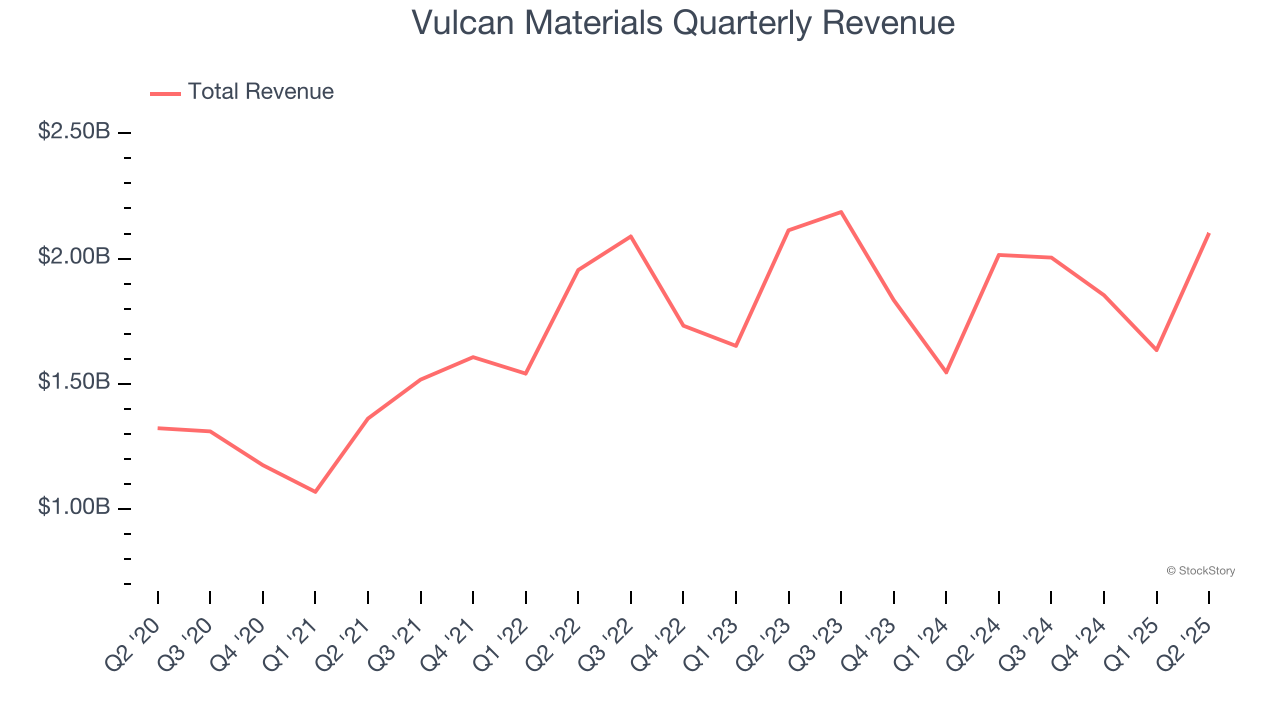
Long-term growth is the most important, but within industrials, a half-decade historical view may miss new industry trends or demand cycles. Vulcan Materials’s recent performance shows its demand has slowed as its revenue was flat over the last two years. 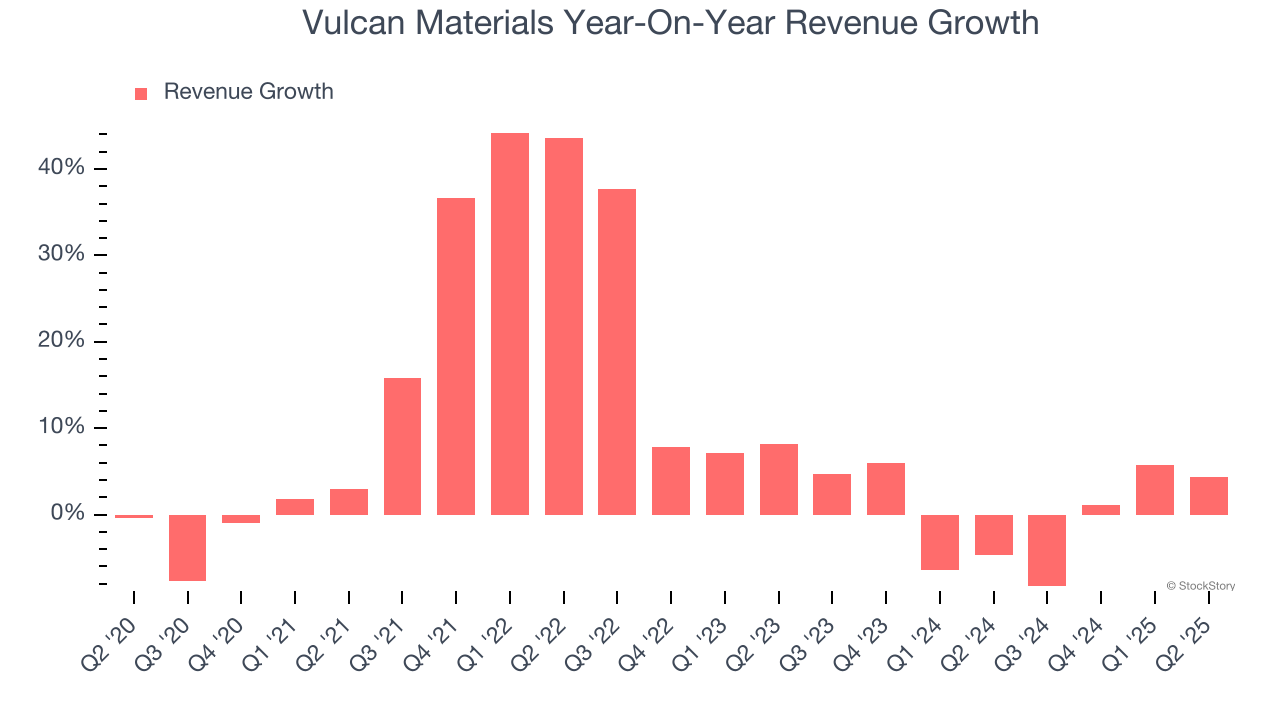
Vulcan Materials also discloses its number of tons shipped, which reached 59.3 million in the latest quarter. Over the last two years, Vulcan Materials’s tons shipped averaged 3.3% year-on-year declines. Because this number is lower than its revenue growth during the same period, we can see the company’s monetization has risen. 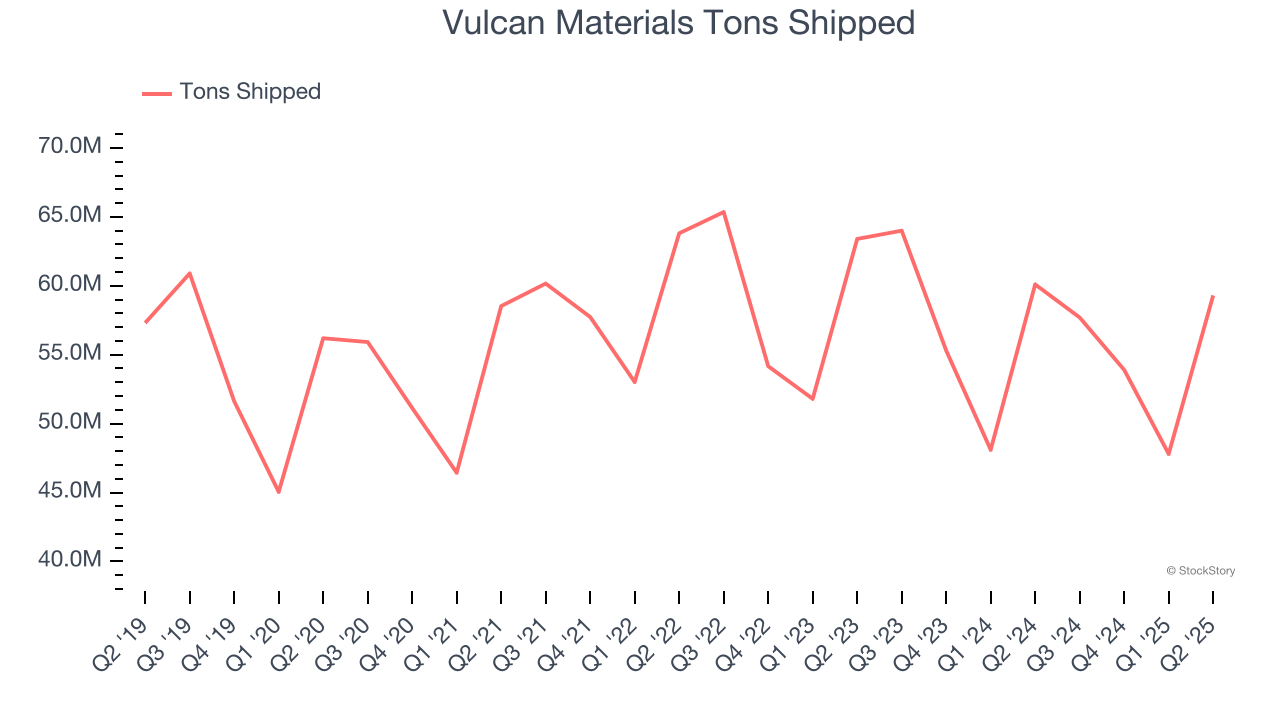
This quarter, Vulcan Materials’s revenue grew by 4.4% year on year to $2.10 billion, falling short of Wall Street’s estimates.
Looking ahead, sell-side analysts expect revenue to grow 11.1% over the next 12 months, an improvement versus the last two years. This projection is commendable and implies its newer products and services will spur better top-line performance.
Today’s young investors won’t have read the timeless lessons in Gorilla Game: Picking Winners In High Technology because it was written more than 20 years ago when Microsoft and Apple were first establishing their supremacy. But if we apply the same principles, then enterprise software stocks leveraging their own generative AI capabilities may well be the Gorillas of the future. So, in that spirit, we are excited to present our Special Free Report on a profitable, fast-growing enterprise software stock that is already riding the automation wave and looking to catch the generative AI next.
Operating Margin
Operating margin is an important measure of profitability as it shows the portion of revenue left after accounting for all core expenses – everything from the cost of goods sold to advertising and wages. It’s also useful for comparing profitability across companies with different levels of debt and tax rates because it excludes interest and taxes.
Vulcan Materials has been a well-oiled machine over the last five years. It demonstrated elite profitability for an industrials business, boasting an average operating margin of 17.3%. This result was particularly impressive because of its low gross margin, which is mostly a factor of what it sells and takes huge shifts to move meaningfully. Companies have more control over their operating margins, and it’s a show of well-managed operations if they’re high when gross margins are low.
Analyzing the trend in its profitability, Vulcan Materials’s operating margin decreased by 1.9 percentage points over the last five years. This raises questions about the company’s expense base because its revenue growth should have given it leverage on its fixed costs, resulting in better economies of scale and profitability.
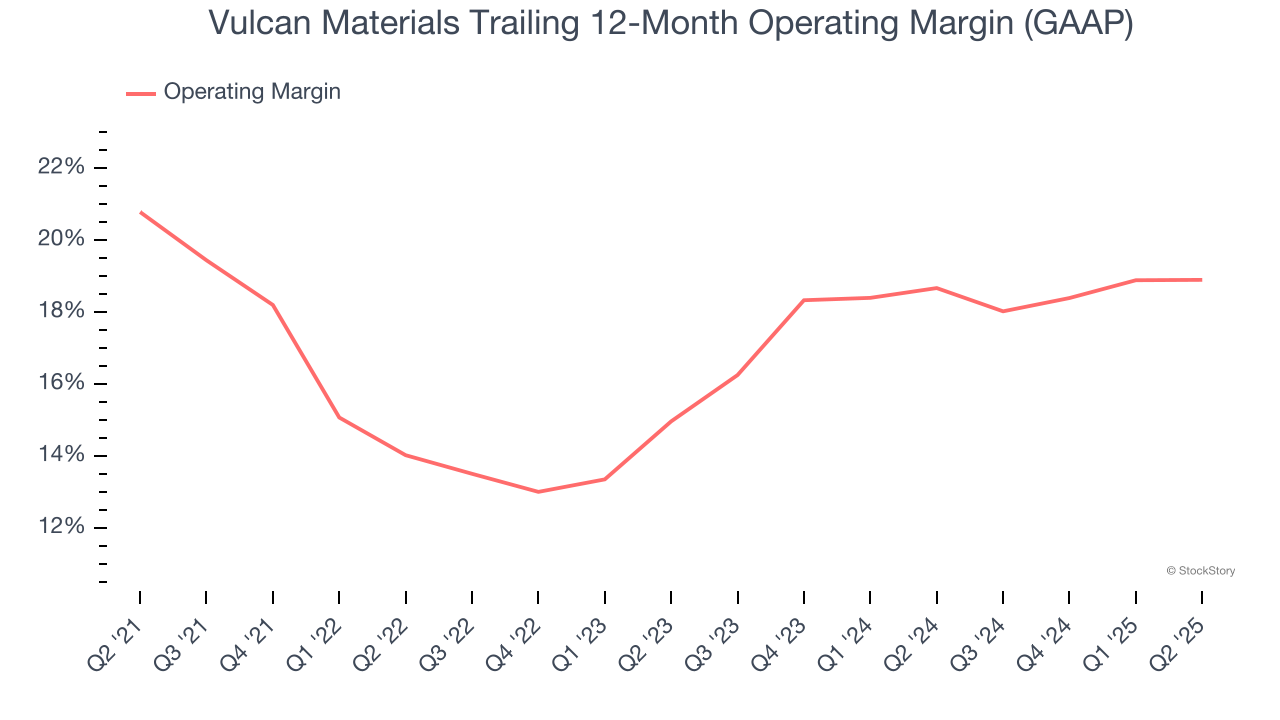
This quarter, Vulcan Materials generated an operating margin profit margin of 22.4%, in line with the same quarter last year. This indicates the company’s cost structure has recently been stable.
Earnings Per Share
We track the long-term change in earnings per share (EPS) for the same reason as long-term revenue growth. Compared to revenue, however, EPS highlights whether a company’s growth is profitable.
Vulcan Materials’s solid 10.2% annual EPS growth over the last five years aligns with its revenue performance. This tells us it maintained its per-share profitability as it expanded.
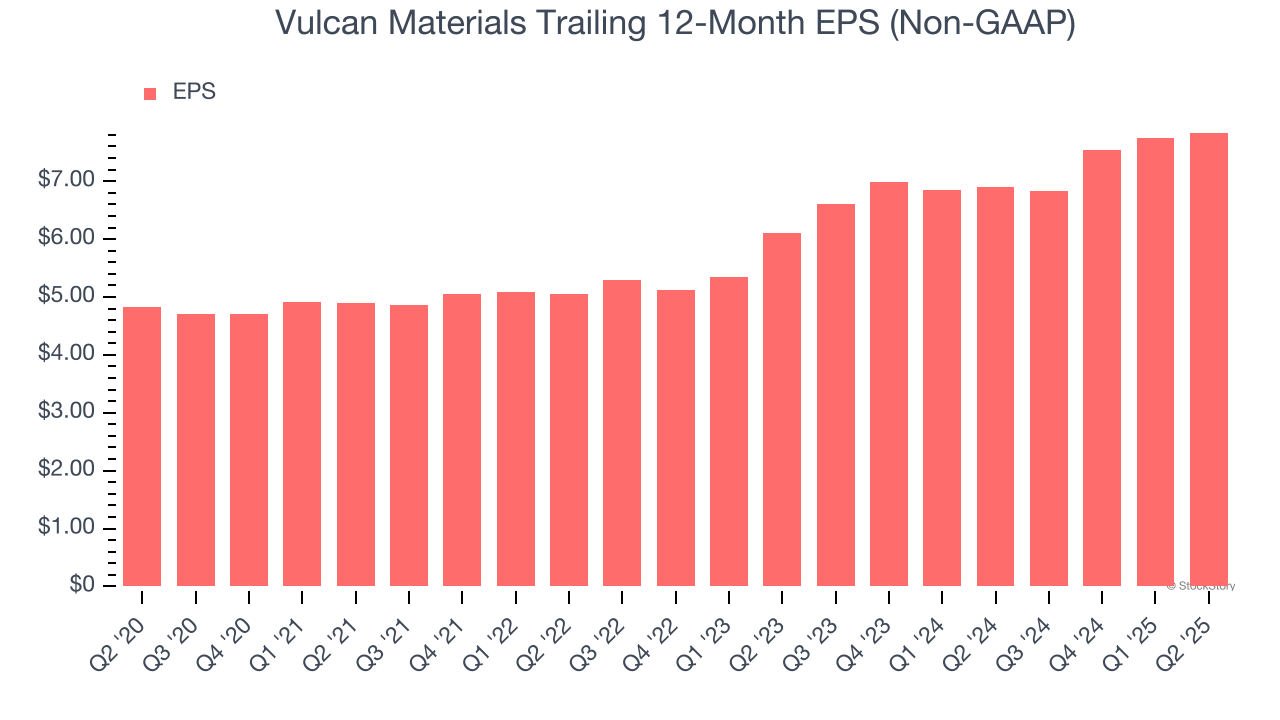
Like with revenue, we analyze EPS over a shorter period to see if we are missing a change in the business.
Vulcan Materials’s two-year annual EPS growth of 13.4% was great and topped its flat revenue.
Diving into Vulcan Materials’s quality of earnings can give us a better understanding of its performance. While we mentioned earlier that Vulcan Materials’s operating margin was flat this quarter, a two-year view shows its margin has expanded by 1.1 percentage points. This was the most relevant factor (aside from the revenue impact) behind its higher earnings; interest expenses and taxes can also affect EPS but don’t tell us as much about a company’s fundamentals.
In Q2, Vulcan Materials reported adjusted EPS at $2.45, up from $2.35 in the same quarter last year. Despite growing year on year, this print missed analysts’ estimates, but we care more about long-term adjusted EPS growth than short-term movements. Over the next 12 months, Wall Street expects Vulcan Materials’s full-year EPS of $7.84 to grow 13.4%.
Key Takeaways from Vulcan Materials’s Q2 Results
We struggled to find many positives in these results. Its revenue missed and its EBITDA fell short of Wall Street’s estimates. Overall, this was a softer quarter. The stock traded down 5.1% to $259.00 immediately following the results.
Vulcan Materials may have had a tough quarter, but does that actually create an opportunity to invest right now? The latest quarter does matter, but not nearly as much as longer-term fundamentals and valuation, when deciding if the stock is a buy. We cover that in our actionable full research report which you can read here, it’s free.
